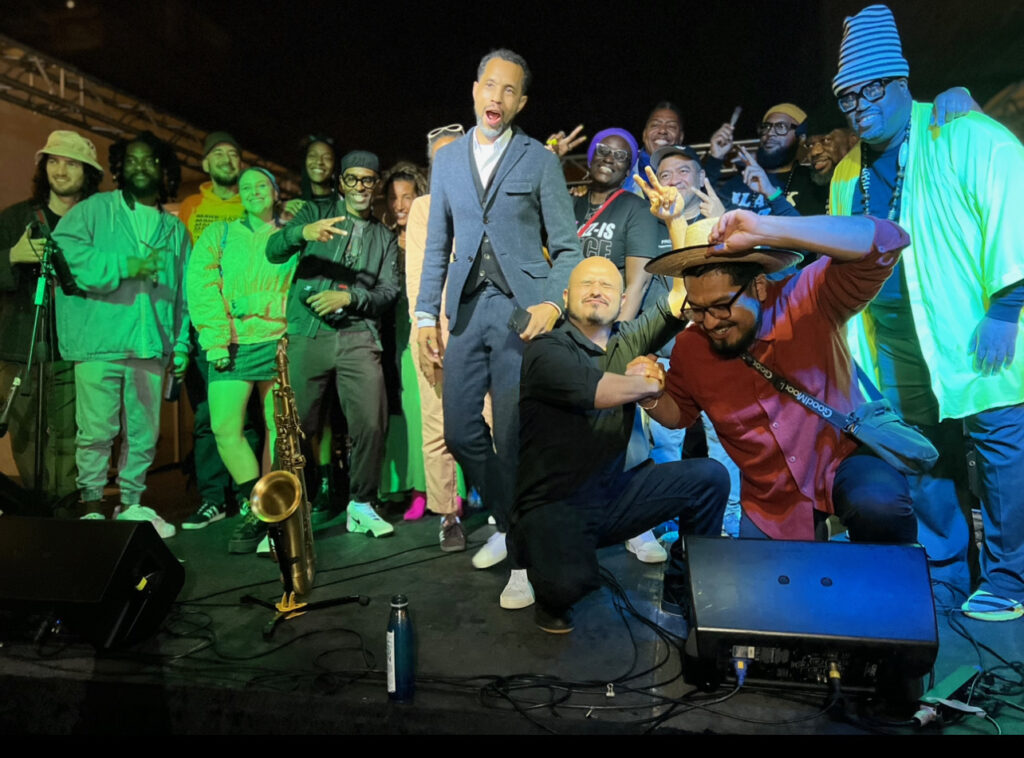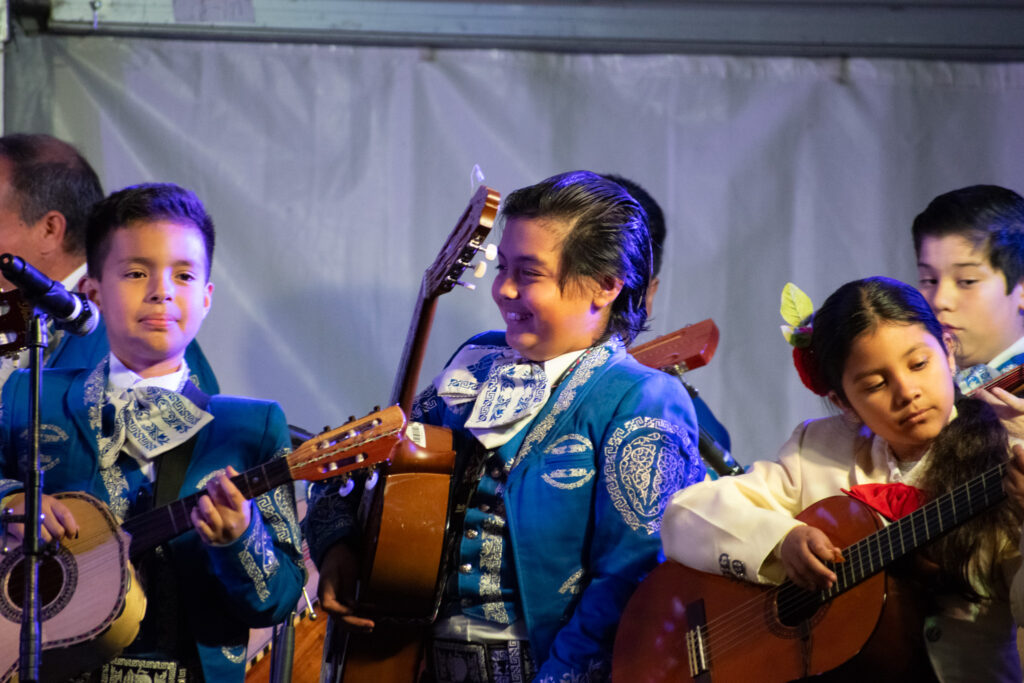
Guillermo Tejeda and the Neighborhood Orchestra performing at the Venice Beach Jazz Festival.
Guillermo Tejeda
The first thing Guillermo Tejeda does when he visits a new school is hunt for the piano. At most schools, the teacher finds a dusty old instrument, out of tune, stashed away in a dark closet.
The cobwebs tell him all he needs to know about how little arts education those students have been getting. His go-to technique to get them more jazzed about learning is to tickle the ivories, make that piano come back to life.
“I’ll bring it out, dust it off. I’ll bring students into the auditorium and I’ll do lessons there,” said Tejeda, a fourth grade teacher at Wadsworth Elementary in hardscrabble South Central Los Angeles. “I’m telling you, when I bring in song, when I bring music and performance into the classroom, the students light up in a way that really creates a meaningful experience for them.”
A schoolteacher who is also a jazz musician and a member of the Neighborhood Orchestra Collective, Tejeda uses music in general and the narrative of the LA jazz scene in particular, to teach about history, race and culture, as well as to spark joy in the classroom. A father of three currently on parental leave with his 11-month-old daughter Maya, Tejeda started playing the guitar at the age of 6. His grandfather, a migrant farm worker with a love of mariachi and a hand gnarled from picking in the fields, taught him how to play.
“I’m from East LA and I became a teacher because I wanted to be the teacher that I never had,” he said. “We come from a marginalized community where it’s hard to be a teacher. A lot of the adults are stressed out. People are not feeling joy. How do we bring more joy? How do we bring more meaning into our lives? I think music is that vehicle.”
Tejeda takes an expansive view of education that integrates the arts into all the disciplines to bring learning to life for children. His teaching feeds his music, he says, and his music feeds his teaching.
“I wish I had a teacher like Guillermo when I was in fourth grade,” said Elmo Lovano, the founder of Jammcard: The Music Professionals Network, who developed School Gig, an app that connects artists to schools. “He’s a passionate guy. He’s incredibly talented. It’s important for artists to know you can still be doing your art, but being a teacher could be an amazing opportunity for you to make a living, stay at home, support your family, give back to the kids, the next generation, and also still do you.”
Music is the prism through which his students become immersed in the history of their city, its politics and culture. He wants his students to be in tune with their heritage.
“I teach on 41st and Central, which is a historic jazz corridor,” he said. “And when I got to that school site, it surprised me that so few teachers talked about that. The first thing I did was write a lesson plan about it.”
Tejeda, whose students call him ‘Mister’ as a nickname, makes sure his class learns about the rich legacy of jazz in Los Angeles. For example, the historic Central Avenue jazz corridor was, for decades a cultural mecca, the heart of the African-American community in the city. At a time when most of the country was rigidly segregated, it was also something of an oasis, a place where people of all races and classes came together over music. There, a pantheon of jazz luminaries, including Charlie Parker, Miles Davis, Duke Ellington, Billie Holiday and Jelly Roll Morton, played to full houses.
“The giants of Central Avenue may have gone, but their footprints still remain on all of American culture,” as basketball great Kareem Abdul-Jabbar once put it. “The jazz musicians and record promoters also gave birth to rock ‘n’ roll, rhythm and blues, hip-hop and rap.”

Steeping in the often overlooked history of their neighborhood, Tejeda says, can help children sharpen their sense of identity, belonging and pride.
“These kids have no idea how special and beautiful their neighborhoods are because all they see on the news is how messed up it is,” said Tejeda, long a champion of culturally relevant pedagogy. “I want them to know this is the place, right here in your hood, this is where a lot of jazz music was born.”
Music often resonates with children on a deeper level than other forms of instruction. Tejeda is moved to tears remembering one little boy who had trouble engaging at school because of trauma at home. He only opened up when they began to play the piano together at recess. The piano became his sanctuary.
“I’m shook when I come home because a lot of these kids are dealing with very hard stuff and they’re so resilient,” said Tejeda, his voice thick with emotion.
“Yes, math and science is important but the whole child is important, that’s what drives me.”
Music also enhances both math and reading performance, experts say, perhaps partly because it enhances the neuroplasticity of the brain. Music amplifies learning across subject areas, experts say.
“Music and movement in addition to the more common modalities of written and verbal instruction is critical for including all kinds of learners in a well-rounded education,” said Jessica Mele, interim executive director of Create CA, an advocacy group. “It’s particularly beneficial for students whose first language is not English. Using art as a window into culture, race and history can engage students in complex conversations that they might not otherwise engage in.”
Music can also be healing, research suggests. As a boy, Tejeda suffered from a stutter that only subsided when he sang.
“I keep it real with the kids because I see myself in them,” he said. “It’s crazy how impactful music has been for me.”
It’s also a uniquely social experience that invites children to collaborate with their peers on projects that both require and reward focus and discipline, qualities that fuel academic success, experts say. Children practiced in the arts become accustomed to working collectively toward ambitious long-term goals.
Perhaps most importantly for Tejeda, children often find their voice through music and the arts. They can gain a sense of confidence, social-emotional well-being and a passion for lifelong learning.
“The end goals of music and education aren’t to memorize curriculums or key terms,” said Tejeda. “It’s really to find out who you are. It’s about self-determination and growing the full human being. I’m so excited to see this synergy of music and education because they are inextricable.”
Tejeda’s ambition is to make school so stimulating that children want to go there every day because they are deeply engaged in their studies. At a time of chronic absenteeism and plummeting test scores, he has a transformative vision of arts education as reinvigorating the classroom.
“I feel a deep calling to help effect change across California classrooms,” he said. “I am never going to stop teaching, because teaching and education is so essential to my soul. It is at the core of who I am,” but this “is a critical time for me to put my work into the next gear and figure out how I’m going to apply my passion and expertise to affect tangible change, more urgently, on a wider scale.”
Going forward, he hopes to pursue arts education advocacy on a broader level. He is also developing a new arts-driven curriculum, to “unleash the symphony of learning,” as Proposition 28, the state’s groundbreaking 2022 arts initiative, ramps up.
“It’s like out of my dreams and into reality,” he said. “We’re going to create a new world for students. This is a revolutionary time.”





